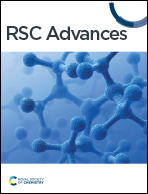Second-phase-induced fluorescence quenching in non-equivalent substituted red phosphors†
Abstract
Concentration quenching, which generally originates from serious energy migrations among the uniformly distributed luminescent centers in the host matrix, is a key factor to influence the luminescence properties of materials. Different from previous reports, we demonstrate a novel fluorescence-quenching mechanism attributable to the second-phase Eu2W2O9 in non-equivalent substituted SrWO4:xEu3+ phosphors. The crystal structure, elemental distribution, and luminescence properties of the as-prepared SrWO4:xEu3+ phosphors are systematically investigated. A second-phase Eu2W2O9 is confirmed when the Eu3+-doping concentration exceeds 20%, which produces the new structure defects and energy-transfer paths, resulting in fluorescence quenching in this material. This finding gives a new perspective to analyze the concentration-quenching mechanism of the non-equivalent substituted phosphors and can help in the design of new, efficient luminescence materials. In addition, the as-prepared SrWO4:xEu3+ phosphors exhibit a strong intrinsic excitation in the range of 355–425 nm, which is accompanied by the Commission Internationale de I'Eclairage (CIE) coordinates at (0.653, 0.347) and stable color purity of up to 94.52%. A packaged white light-emitting diode with CIE chromaticity coordinates of (0.398, 0.335), correlated color temperature of 3132 K, and color rendering index of 84.3 is fabricated by SrWO4:20%Eu3+ phosphors with blue BAM:Eu2+ and green YAGB:Tb3+ phosphors in a near-ultraviolet chip.



 Please wait while we load your content...
Please wait while we load your content...